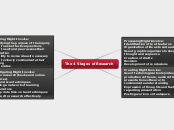The 4 Stages of Research
Processing Might Involve:
Identification of text features
Organization of ideas to suit audience
Use of graphic organizers to show thought and sequence
Creation of drafts
Revision
Development of conclusions
Strategies:
Shared reading activities that model text formats
Graphic organizers that utilize technology
Lessons on how to effectively use graphic organizers
Opportunity to peer revise/collaborate using technology
Student teaching opportunities with technological formats
Creating Might Involve:
Use of technological tools (video production software, audio software, presentation software) to communicate understanding
Expression of thoughts and feelings regarding presentation
Posting work on virtual space
Strategies:
Reflection exercises on wikis, tweets, or blogs
Self assessments
Surveys
Presentation lessons (real life, flipped class, online tutorials)
Exploring Might Involve:
Identifying the purpose of the inquiry
Ability to ask effective questions
Ability to self and peer assess their exploration
Flexibility to revise ideas if necessary
Ability to clearly communicate their thinking
Collaborates
Strategies:
Use mind mapping software to generate ideas
Brainstorm with their peers
Question Matrix usage to illicit thinking
Think Pair Share
Technological tools (wikis, blogs, etc.)
Investigating Might Involve:
How to research (books and online resources)
Skim and scan techniques
Creating a network of learning collaborators
Appropriate time on task techniques required to research effectively
Strategies:
Online tutorials that teach how to use appropriate researching tools.
Peer tutors that teach access to learning materials.
Shared reading exercises that teach skimming and scanning.
Virtual field trips that “enlarge the scope of the inquiry.” (Together for Learning, 47)
